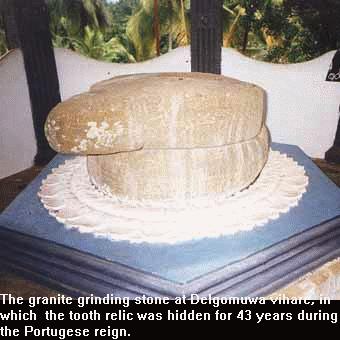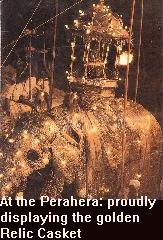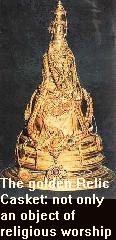

![]()
Keeping with traditions, the Tooth Relic has been taken in procession annually for over 300 years, through the streets of Kandy, in what is known as the "Kandy Esala Perahera." This pageant affords an opportunity to devotees to pay homage to the Relic
In the coming weeks for many people, all roads will lead to Kandy, where the annual Esala Perahera and Festival is to take place. Peraheras are organised processions, and are known to have been held in India and Sri Lanka for well over 300 years. Fa Hien, the Chinese traveller who visited Anuradhapura, the capital city of the island, in the 6th Century A. D. - has described witnessing a Buddhist religious ceremony, when the Sacred Tooth Relic was taken around the city once a year, with great pomp and pageantry.
The Mahavamsa - Sri Lanka’s historical chronicle, and also the Dhatuwamsa has recorded that the Sacred Tooth Relic had been smuggled into the island, hidden in the hair of a Brahamin Princess named, Hemamali. King Meghawanna who ruled from Anuradhapura (300-333 A.D.) had received the Relic with great reverence, paid the highest of honours and had laid it in an urn of pure crystal and deposited it in a building called the Dhammachakka. Ever since it was considered as the palladium of the Sinhalese Buddhist Kingdom and was considered to be, not only an object of religious worship. For that reason, the Sacred Tooth Relic had been shifted from place to place, when the king shifted his palace to places of safety, when threatened with rebellion or invasion.
When the Chola South Indian forces invaded Lanka in the 11th and 12th centuries, the Relic was moved by King Vijayabahu I in 1070 A.D. to a specially built "Maligawa" at Polonnaruwa. History records that whenever there was famine a special exposition of the Tooth Relic took place, and soon after, great dark clouds bringing forth rain appeared. As stated before whenever there was a threat to the kingdom, the Maha Sangha saw that the Relic was shifted to safety at Dambadeniya, Sitawaka (modern day Avissawella), Hanguranketa, Hindagala (near Peradeniya), and finally to the "Maligawa" at Kandy, which was sited at a higher elevation than the Royal Palace.
 When
the Portuguese arrived in Sri Lanka in 1505 A.D., they became aware of the
importance of the Sacred Tooth Relic. They made a serious effort to take custody
of it. In that background of hostility 446 years ago, Hiripitya Dissawe Nilame
of Sitawake handed over the Relic to King Mayadunne for safe keeping.
Thereafter for 43 years it was zealously guarded at the Delgomuwe Raja Maha
Vihara, Kuruwita and hidden in a specially made large granite grinding stone,
now to be seen at this ancient Temple.
When
the Portuguese arrived in Sri Lanka in 1505 A.D., they became aware of the
importance of the Sacred Tooth Relic. They made a serious effort to take custody
of it. In that background of hostility 446 years ago, Hiripitya Dissawe Nilame
of Sitawake handed over the Relic to King Mayadunne for safe keeping.
Thereafter for 43 years it was zealously guarded at the Delgomuwe Raja Maha
Vihara, Kuruwita and hidden in a specially made large granite grinding stone,
now to be seen at this ancient Temple.
Keeping with tradition, the Sacred Tooth Relic has been taken in procession annually for over 300 years, through the streets of Kandy, in what is known as the "Kandy Esala Perahera". This pageant affords an opportunity to devotees to pay homage to the Relic. The Esala Perahera begins with the planting of Kap in each of the four devales dedicated to the Hindu Gods, i.e., Natha, Maha Vishnu, Kataragama and Pattini.
The Devales’ processions that later on take part along with the main Maligawa Perahera, signifies the Hindu influence, because the Last Kings of Kandy had married from the Nayakkar dynasty, in Tanjore.
The planting of Kap signifies a vow taken to hold the Perahera. This is followed by the purification ceremonies. The blessings of gods are sought for the "Kumbal Perahera" to begin for five consecutive nights.
The final nights have the Randoli Perahera where offerings are made by the crowds present. At this grand finale more decorated elephants (about 125 in number) take part in addition to hundreds of bands of Kandyan and Low Country dancing troupes.
Amidst this colourful activity lit by torches, rows of Kandyan chieftains all associated with the Maligawa and the devales, dressed in the best colourful regalia move slowly with measured steps keeping pace with the music.
Robert Knox in 1660, in his An Historical Relation of Ceylon states, "Formerly the king himself in person used to ride on horse back with all his train before him in this solemnity, but now he delights not in these shows."
Whilst the incessant flute music and drumming of over 200 persons take place the noise reverberates in the valley of Kandy which is surrounded by the Hantane mountain range, Udawattekelle hillock and Dharmaraja hill.

 A
beautifully dressed and illuminated Elephant Tusker moves in slow majestic gait
in regal manner proudly displaying the golden Relic Casket, over which a cloth
brocade canopy is held high. All this takes place to the cries of "Sadhu
Sadhu" from thousands of people who have for hours lined the streets in
patient silent wait. The Diyawadane Nilame who is one of the three custodian
Trustees of the Sacred Tooth Relic, supported by his Basnayake Nilames moves
behind the Tusker, as it is his principal responsibility to ensure the great
annual event is performed in tradition.
A
beautifully dressed and illuminated Elephant Tusker moves in slow majestic gait
in regal manner proudly displaying the golden Relic Casket, over which a cloth
brocade canopy is held high. All this takes place to the cries of "Sadhu
Sadhu" from thousands of people who have for hours lined the streets in
patient silent wait. The Diyawadane Nilame who is one of the three custodian
Trustees of the Sacred Tooth Relic, supported by his Basnayake Nilames moves
behind the Tusker, as it is his principal responsibility to ensure the great
annual event is performed in tradition.
On the final night the Perahera goes to Gaman Maluwa (Adahana Maluwa) where the Golden Karanduwa (Casket) is kept, until the day Perahera begins on the following day. The water cutting ceremony is performed at Gannoruwa (Getambe) on the Mahaweli Ganga.
At this place using a gold sword water of the river is "cut" by the Kapurala at dawn. Kapuralas recite ‘Ashtaka’ or Jayamangala Gatha keeping with traditions and water is taken into a goblet to be kept at devales, until the conclusion of the Perahera in the following year.
This annual Buddhist pagaent needs the services of thousands of helpers to perform numerous chores. This work is done in the same way their ancestors did perform and in accordance with caste as far as possible.
To them it is more than a customary ritual, it is a duty to be done once a year, before the fields are ploughed for the next season.
The final episode of this great event is when the Diyawadana Nilame together with other Nilames and Kapuralas officially report to the King or Head of State that the Perahera has been successfully held and concluded.
Continue to Plus page 8 - A plea for Priya
Return to the Plus contents page
![]()
| HOME PAGE | FRONT PAGE | EDITORIAL/OPINION | NEWS / COMMENT | BUSINESS
Please send your comments and suggestions on this web site to
info@suntimes.is.lk or to
webmaster@infolabs.is.lk